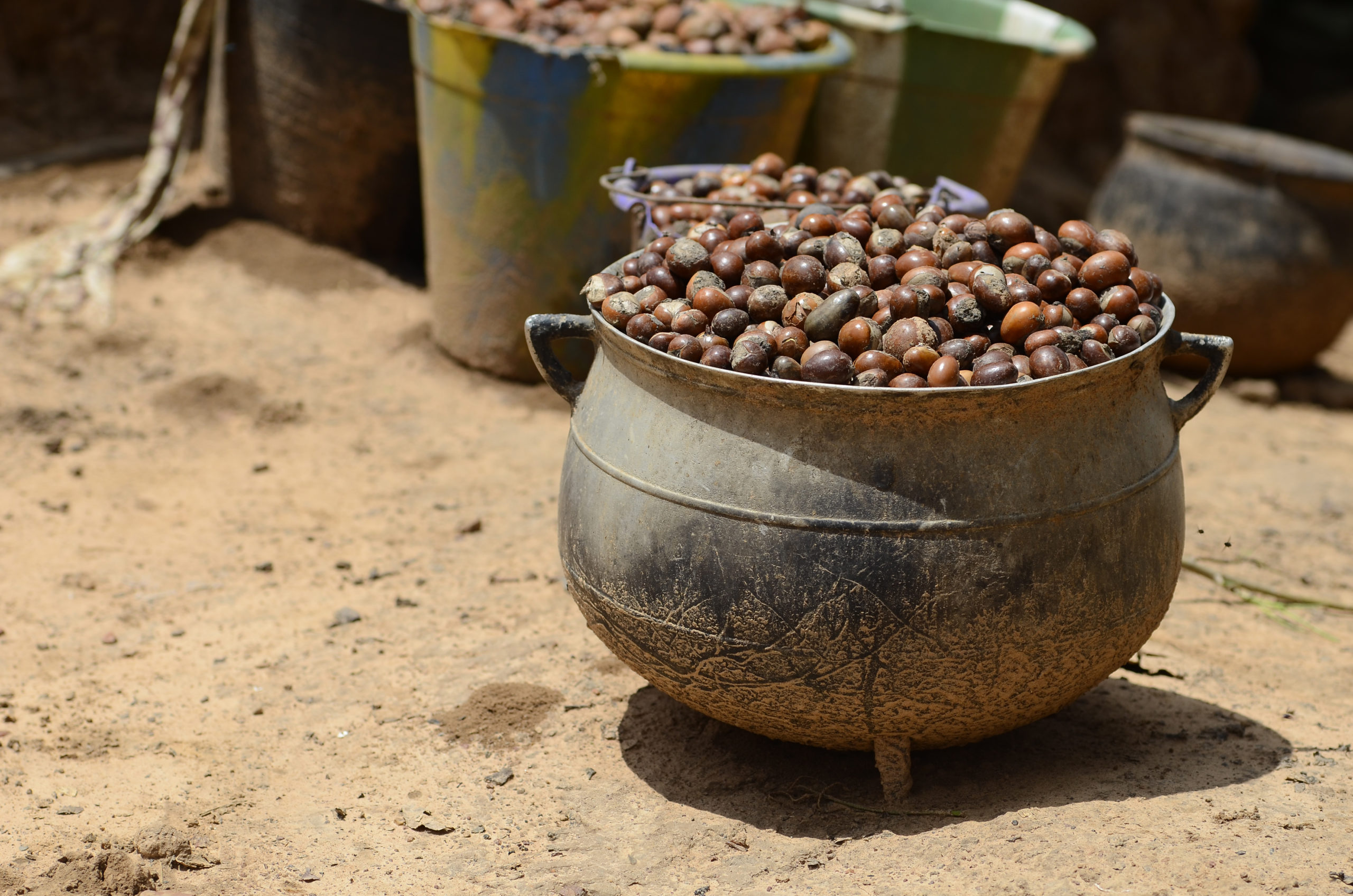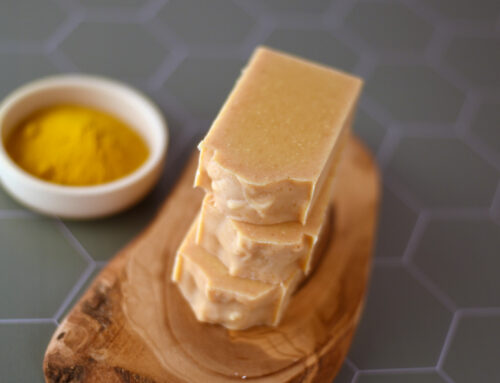Shea butter is a creamy off-white or pale yellow fat which is extracted from nuts that are produced by the African shea tree (karite tree).
Interestingly enough, shea trees do not produce fruit before they are 20 years old, and the trees do not go into full production until they are around 45 years old. Shea trees grow naturally in the dry Savanna region of West Africa, Northern Uganda, and Southern Sudan, and they amazingly produce fruit for up to 200 years.
There are mechanical ways to produce shea butter, however, the long-established method of hand-processed extraction continues to be followed amongst African women who group together for the activity, and ultimately, they provide their families with economic means resulting from their efforts.
The traditional method of shea butter extraction is laborious:
- Shea fruits are collected from the ground after they fall from the shea tree. The fruit itself is sweet and edible.
- The kernels are removed from the fruit and the shell surrounding the kernels are cracked to expose the nuts.
- The nuts are removed from the shells and are left to dry in the sun.
- Once dry, the nuts are crushed and ground into small pieces.
- The small pieces are roasted and hand-stirred in large pots over wood fires, which releases the fat and transforms the nuts into a paste.
- Water is added to the paste and then the mixture is whipped by hand.
- The mixture becomes a thickened paste as it cools and it is then washed with clean water.
- The paste is then re-heated which causes fats to rise to the top, and the desired shea oil to settle to the bottom.
- The fat is skimmed off the top and the oil that has collected on the bottom hardens as it cools. This hardened oil, which is raw shea butter, is then packaged and ready for shipment.
Shea butter differs in color because shea nuts range in color from nearly white to yellow. Shea butter also differs in odor. Shea butter that smells slightly smoky has picked up the scent from the open fire where it was hand-processed. It is said if shea butter has no odor, it has either been over-processed (is not raw), or it has aged and is not fresh. Shea butter should never smell rancid. If it does, it should be discarded.
Shea butter is one of the top ingredients included in cosmetics today. Shea butter is loaded with natural vitamins (A, E, F) and antioxidants. In its raw state, shea butter is often used for smoothing wrinkles, sun protection, scar prevention, eczema, skin allergies, insect bites, and as a hair product that adds moisture and sheen. Shea butter is also used as a cooking oil.
People that are allergic to nuts are generally not allergic to shea butter. Even though shea butter is extracted from the nut of a fruit, research indicates that shea butter does not contain the proteins that are considered allergens.
Shea is also available in oil form, however, this form of shea does not contain the same level of vitamins, antioxidants, and other beneficial properties in comparison to raw shea butter.
Shea Butter Fatty Acid Profile and Soap Qualities
Shea butter is also a desirable addition to soap. The fatty acid profile and soap qualities are:
- Lauric Acid (hardness, cleansing, bubbly lather) 0%
- Myristic Acid (hardness, cleansing, bubbly lather) 0%
- Linoleic Acid (conditioning, moisturizing, lather silkiness) 4-10%
- Oleic Acid (conditioning, moisturizing, later silkiness) 40-50%
- Palmitic Acid (hardness, stable creamy lather) 3-8%
- Ricinoleic Acid (conditioning, moisturizing, stable creamy lather) 0%
- Stearic Acid (hardness, stable lather) 35-45%
- Iodine Value (hardness, conditioning) 45-65 (on a scale of 0-100, with more hardness at 0)
Fatty acid profile and soap qualities of shea oil:
- Lauric Acid (hardness, cleansing, bubbly lather) 0%
- Myristic Acid (hardness, cleansing, bubbly lather) 0%
- Linoleic Acid (conditioning, moisturizing, lather silkiness) 7-15%
- Oleic Acid (conditioning, moisturizing, later silkiness) 68-78%
- Palmitic Acid (hardness, stable creamy lather) 4-7%
- Ricinoleic Acid (conditioning, moisturizing, stable creamy lather) 0%
- Stearic Acid (hardness, stable lather) 6-14%
- Iodine Value (hardness, conditioning) 75-90 (on a scale of 0-100, with more hardness at 0)
As you can see, shea butter does not add to the lather of soap, but it does provide a degree of silky moisturization. Please note that shea oil is not usually used in soap but I wanted to share the profile so you could see the difference between shea butter and shea oil.
Finally, to assist with calculating your soap recipes, the SAP (saponification) value of shea butter is:
- .131 NaOH (Sodium Hydroxide)
- .185 KOH (Potassium Hydroxide)
The SAP value of shea oil is:
- .129 NaOH (Sodium Hyroxide)
- .182 KOH (Potassium Hydroxide)
Shea Butter in Soap Formulation
I personally use shea butter in many of my recipes at 5-15%. I prefer raw shea butter in soap. I want all of the natural goodness that shea butter provides. You can get refined shea butter. I use refined shea butter in lotion. It really is a matter of preference.
Substitutions for Shea Butter in Soap
When we take a look at the fatty acid profile chart, you can sort it by stearic acid or oleic acid to find substitutes. You can substitute shea butter with another butter such as mango, cocoa or even kokum.
Soap Recipes Using Shea Butter
I personally LOVE shea butter in soap so most of my recipes include it. Here are some of my favorites.
- Our duel lye shave soap recipe includes shea butter.
- Natural Calendula and Yellow Brazilian Clay Soap Design
- Juniper Berry Soap









That is so funny, I will inbox you 🙂
Thanks so much. I stuck to one soap recipe and use raw shea butter. Great article!
Does shea accelerate the batch ?
We have helpful research results on shea butter we would like to share with you.. Thank You,
Waiting your response.
Larry
Can you add it to mp soaps?
I have been making soap not quite 2 years. Shea Butter soap is one of my favorites, however, when I use Crisco, I find that to be very nice as well. After learning the cold process, I began hot process (crock pot) and I have not looked back to cold. I have not learned the fluid hot processing, but what I do is good enough. I only use natural ingredients, nothing else added like colorants unless it is a spice. I make and sell these soaps for my church. Not making money for a business, but still I have people asking to buy my soaps and it gives me joy to place the money into the church envelopes. Thanks for all the helpful info.
ezelinnenmelk zeep is perfect voor je huid en haar
Donkey milk cosmetics are perfect
Very useful article.
Elgrecocosmetics.com
Super interesting, thanks for the info! I never realized that the fruit was edible, especially since they wait for it to fall off the tree! I am curious, do you know what they use the fat for that floats to the top? I would have guessed that that part would be the Shea butter! ☺
Hi Amanda. Question on tempering shea butter. I have been h available no problems with it granulating in my lip and body balms. Still functions well but feels chunky/gritty. I tried tempting but it still does it. Any advice?
Thanks Amanda, as always very useful and extremely interesting information.